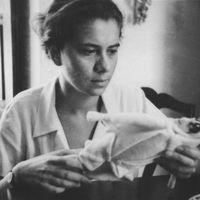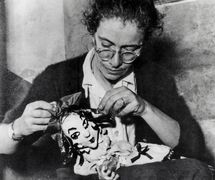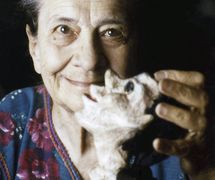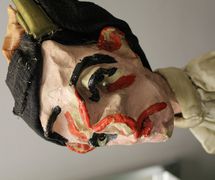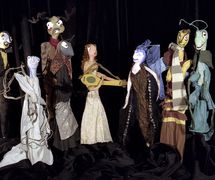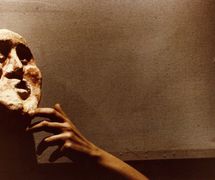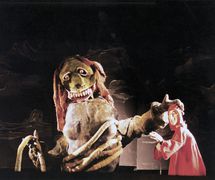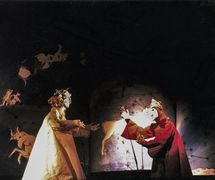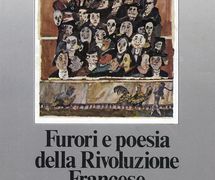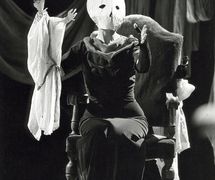Italian puppeteer, author, and teacher. Maria Signorelli was the eldest of the three daughters of Latvian writer Olga Resnevitch, one of the first female doctors in Europe, and Angelo Signorelli, one of the first Italian radiologists. From her earliest childhood Maria was strongly influenced by the cultural richness of her family circle: her mother (an enthusiast of the theatre and the author of a biography of Eleonora Duse) and father held a salon for several years at their home in Rome.
After completing her classical studies, Maria Signorelli enrolled at the Accademia di Belle Arti (Fine Arts Academy) of Rome and began to frequent the set and costume design studio of the Teatro Reale (Royal Theatre), which was at the time under the direction of the Russian painter Nicola Benois. Signorelli’s passion for design, colour and the theatre led her to construct her first puppets out of various materials and found objects. These were first exhibited in 1929 at the Roman gallery Casa d’Arte, owned by the stage director Anton Giulio Bragaglia. After another exhibition, presented by Giorgio de Chirico at the Zak gallery in Paris, she relocated to Berlin for a long stay that culminated in a new exhibition at the Gurlitt gallery. Upon her return to Italy she worked with Bragaglia on a number of theatrical productions that were performed in Rome at the Teatro degli Indipendenti and later at the Teatro delle Arti. In 1934, she collaborated with Carlo Rende to create the Pluriscenio M, a stage set conceived to allow the presentation of seven different scenery designs at once. This invention earned the admiration of Bragaglia and praise from the founder of Futurism, Filippo Tommaso Marinetti.
In 1937, the Swiss singer Maria Amstad gave Signorelli the suggestion for her first puppet shows, La Boîte à joujoux (The Box of Toys/The Toy Box, based on the ballet for children of Claude Debussy) and Bastien et Bastienne (Bastien and Bastienne, based on the one-act comic opera by Wolfgang Amadeus Mozart), which were staged in Rome. In 1939, she married the educator Luigi Volpicelli.
Although she was very active as a set and costume designer during this period, it was only after World War II, in 1947, that Maria Signorelli founded her own company, the Opera dei Burattini. Its productions followed in rapid succession and attracted collaborations from prominent artists, notably the actors Lina Wertmüller, Gabriele Ferzetti and Scilla Brini; painters and set designers Enrico Prampolini, Ruggero Savinio and Toti Scialoja; composers Ennio Porrino, Vieri Tosatti and Roman Vlad; and directors Margherita Wallman and Giuseppe De Martino. Little by little a repertoire was established, both for adults attracted by the marvellously poetic stagings, and for children to whom the puppets revealed a fantastical and enlightening new world. Great literary texts inspired the company’s first productions: Il re cervo (The King Stag) by Carlo Gozzi and Usignolo e la rosa (The Nightingale and the Rose) by Oscar Wilde in 1952; La favola del pesciolino d’oro (The Tale of the Little Goldfish) by Alexander Pushkin in 1953; La tempesta, based on The Tempest by William Shakespeare in 1955; Faust by Guido Bonneschk in 1963-1964; Dante’s Inferno in 1982; La Rivoluzione Francese (The French Revolution) by Guido Ceronetti in 1983; and Bertolt Brecht’s Antigone in 1984, among others.
The puppet ballets – El Retablo de Maese Pedro (Master Peter’s Puppet Show, 1951) by Manuel de Falla, La Boîte à joujoux (The Box of Toys, 1954) by Claude Debussy, and Sergei Prokofiev’s Cinderella (1972) – allowed Signorelli to deploy her talent and creativity as an animator and constructor of puppets, demonstrating great simplicity at some times and sophistication at others.
In addition to her work for the stage, she undertook to transmit the tradition, and, in 1972, a position was created for her to teach puppet theatre at the University of Bologna. She also created programmes for radio and television, gave lectures, and wrote articles for scholarly journals and educational publications. She is the author of
Storia e tecnica del teatro delle ombre (History and Technique of Shadow Theatre, 1981), Il Gioco del burattinaio (The Play of the Puppeteer, 1975) and Srumenti musicali fatti in casa (Homemade Musical Instruments, 1977), among other books.
Her passion as a collector was the origin for a number of exhibitions on puppet theatre across the ages, both in Italy and abroad; she was the editor of the exhibition catalogue Una vita di teatro tra marionette e burattini in 1983. Furthermore, her own creations were put on exhibit around the world.
She was a member of the UNIMA Presidium (later renamed Executive Committee), and, in 1980, founded UNIMA-Italia, serving for many years as its Honorary President.
(See Italy.)
Bibliography
- Cecchini, Franco, and Loretta Mozzoni. Il teatro delle meraviglie. Marionette e burattini dalla collezione Maria Signorelli [The Theatre of Wonders. Marionettes and Glove Puppets from the Collection of Maria Signorelli]. Exhibition catalogue. Jesi: Sfera Edizioni, 2003.
- Giuffré, Maurizio. Maria Signorelli : teatro, marionette e burattini. Exhibition catalogue. Sestri Levante: Joshua Libri, 2000.
- McCormick, John, with Alfonso Cipolla and Alessandro Napoli. The Italian Puppet Theater – A History. Jefferson (NC): McFarland & Co., 2010.
- Volpicelli, Giuseppina, ed. Piccoli personaggi, grandi incanti [Little Characters, Great Charm]. Exhibition catalogue. Treviso, 2002.
- Volpicelli, Giuseppina, and Patrizia Veroli, eds. Il teatro delle meraviglie. La collezione di marionette e burattini di Maria Signorelli. I fondali per marionette del Palazzo Mereghi di Jesi [The Theatre of Wonders. The Collection of Marionettes and Glove Puppets of Maria Signorelli. The Backdrops for Marionettes of the Palazzo Mereghi di Jesi]. Exhibition catalogue. Jesi, 2003.









